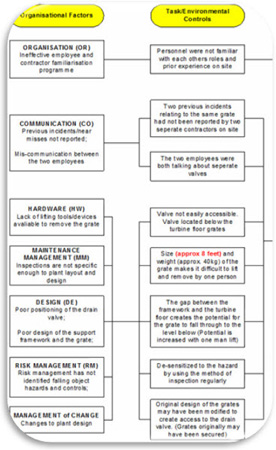 RiskPro consultants have been trained in the ICAM (Incident Cause Analysis Method) application of investigation and analysis. ICAM is a systematic safety investigation analysis method which aims to identify local factors (root causes) and failures within the broader organisation and productive system (eg. communication, training, operating procedures, incompatible goals, organisational culture, equipment, etc) which contribute to the incident. Through this analysis of incident information, factual causes are identified enabling qualified recommendations for improvement and prevention.
RiskPro consultants have been trained in the ICAM (Incident Cause Analysis Method) application of investigation and analysis. ICAM is a systematic safety investigation analysis method which aims to identify local factors (root causes) and failures within the broader organisation and productive system (eg. communication, training, operating procedures, incompatible goals, organisational culture, equipment, etc) which contribute to the incident. Through this analysis of incident information, factual causes are identified enabling qualified recommendations for improvement and prevention.
The initial collection of data (analysis of findings) is generally divided into five (5) main areas:
1. People;
2. Environment;
3. Equipment;
4. Procedures; and
5. Organisation.
Conditions, actions or deficiencies in each of these five main areas are examined for their potential as contributing factors to the subsequent incident. Information generated from this process of the investigation (analysis of findings) is then transferred, classified and charted into one of the following five (5) contributory levels:
1. Organisational Factors (OFTs);
2. Task/Environmental Conditions;
3. Individual/Team Actions;
4. Absent or Failed Defences; and/or
5. Non-Contributory Facts.
The next incident analysis step classifies system failures into Organisational Factor Types (OFTs). These factors could potentially produce the conditions that affect or direct performance. This investigation process analyses the interaction of the local conditions combined with the organisational factors. ICAM classifies OFTs as per the table below.
RiskPro provide clear and comprehensive reports with recommendations for improvement and prevention.
| HW |
Hardware |
Selection, quality, availability and position in life-cycle of tools, equipment and components |
| TR |
Training |
Provision of the correct knowledge and skills for persons undertaking the task |
| OR |
Organisation |
Structure of responsibility and accountability |
| CO |
Communication |
Communication mechanisms and transparency |
| IG |
Incompatible Goals |
Relationship or conflict between production, safety, planning and/or economic goals |
| PR |
Procedures |
Accurate, understandable procedures which are known and used |
| MM |
Maintenance Management |
Maintenance system involving planning, resourcing and type of maintenance |
| DE |
Design |
Plant, equipment, building, layout design |
| RM |
Risk Management |
Systematic application of processes/procedures and methods for identifying and analysing risk |
| MC |
Management of Change |
Systematic assessment and application of change |
| CM |
Contractor Management |
Evaluation, selection, retention and monitoring of contracted services |